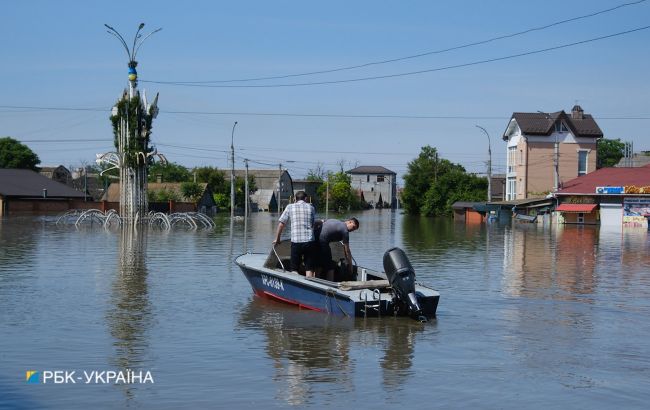Flood water declines after dam break: June 9 updates
 Flooded areas in Kherson (RBC-Ukraine, Vitaliy Nosach)
Flooded areas in Kherson (RBC-Ukraine, Vitaliy Nosach)
On the fourth day after the Kakhovka Hydroelectric Power Plant (HPP) dam was blown up by Russians, the water level in the flooded Kherson region started to decline. However, thousands of homes remain dipped into the water, and the residents' evacuation is ongoing.
Read in detail about the outcomes of the Kakhovka HPP dam blast as of June 9th in the RBC-Ukraine article below.
The water level has decreased
The water level in the Kakhovka Reservoir has dropped another meter. According to "Ukrhydroenergo" ((Ukraine's main hydropower generating company), as of this morning, the water level of the Kakhovka Reservoir in the Nikopol area is at 11.74 meters (about 38.5 feet).
In the past 24 hours, the water level in the Kakhovka Reservoir has dropped another meter, and since the morning of June 6, the water level has fallen a total of 4.7 meters (15.4 feet).
Most of the power plant building is underwater. The earthen insert between the lock and the station is also underwater and continues to deteriorate.
Kherson region
The head of Kherson Regional State Administration Oleksandr Prokudin said that as of 8 am, the water level in the right bank of Kherson is 5.38 meters (17,6 feet), and in Kherson itself - 5.35 meters. However, the water level gradually starts to decrease.
"We can already see that the water level dropped by 20 cm (7,8 inches) overnight. As of this morning, approximately 3,624 homes in 32 settlements in the Kherson region are flooded," said Prokudin.
Meanwhile, Ukraine's State Emergency Service (SES) notes that they stabilized the situation with the water arrival in Kherson, but it is rising downstream of the Ingulets River.
According to experts, the city of Kherson is expected to experience a tendency of decreasing water levels with occasional short-term increases of 1-5 centimeters. The SES representative confirmed that currently, 46 settlements have been affected by flooding. Approximately 600 square kilometers are currently submerged, with about 30% on the right bank, and approximately 70% on the left bank of the Dnipro River.
Mykolaiv region
Meanwhile, in the neighboring Mykolaiv region, the water level continues to recede. As of 9 am, following the explosion at the Kakhovka Hydroelectric Station, the water level stands at 100 centimeters (39.3 inches).
The head of the Mykolaiv Regional State Administration Vitaliy Kim said that the water level in the Inhulets River has remained unchanged for the past two hours.
The situation remains critical in Ukraine as floodwaters continue to pose significant threats to the affected regions. International efforts and local authorities are working tirelessly to mitigate the effects of the ongoing crisis and provide assistance to affected communities.
Evacuation is underway
Prokudin said that as of this morning, the number of people evacuated has reached 2,352. Animal rescue efforts are also underway, with about 550 animals having been evacuated. Law enforcement authorities have provided slightly higher numbers regarding the evacuees. According to their data, 2,374 people have been evacuated so far.
Police are urging citizens in the flooded areas to evacuate.
Volunteers are not allowed to Kherson
This caution is issued due to the ongoing Russian bombardments and the worsening situation in Kherson. "We will provide separate notifications if there is a need for assistance. Currently, there are enough forces to rescue people and animals from the flooded areas," said the Kherson Regional State Administration.
Zaporizhzhia NPP
The water from the Kakhovka reservoir is necessary for the Zaporizhzhia Nuclear Power Plant (NPP) for its safety systems, therefore the blast at the station could threaten its operating stability. "Energoatom", a state enterprise operating all four nuclear power plants in Ukraine, reports that the water level in the cooling pond of the Zaporizhzhia NPP now is stable.
"As of today, the water level in the Kakhovka reservoir in the Nikopol region is 11.74 meters, and in the cooling pond of the Zaporizhzhia NPP - 16.66 meters. This is fully sufficient to meet the needs of the station," said the company's statement.
The power units of Zaporizhzhia NPP have not been operating since September 2022, so there is no evaporation of water from the cooling pond.
Russians admitted blowing up the Kakhovka HPP dam
This is confirmed by occupiers communicating with each other in a telephone conversation intercepted by the Security Service of Ukraine.
"It wasn’t them (the Ukrainians) who blew it up. It was our sabotage group. They wanted to scare them with this dam. It didn't go according to plan, it went beyond what they planned," says a Russian soldier. The occupier describes the aftermath of this disaster, which they are trying to hide in Russia: rising water levels, flooding of territories, and destruction.
The water in Kherson is safe to drink
Officials in Kherson say that the water is supplied from artesian wells located 60-100 meters deep. These sources are in no way connected with the water from the Dnipro River. The issue of water supply in regions that were dependent on the Kakhovka Reservoir has been pressing.
Casualties and injuries
According to the Ministry of Internal Affairs, at least five people have died and another thirteen are missing as a result of a flood caused by the bombing of the Kakhovka dam.

